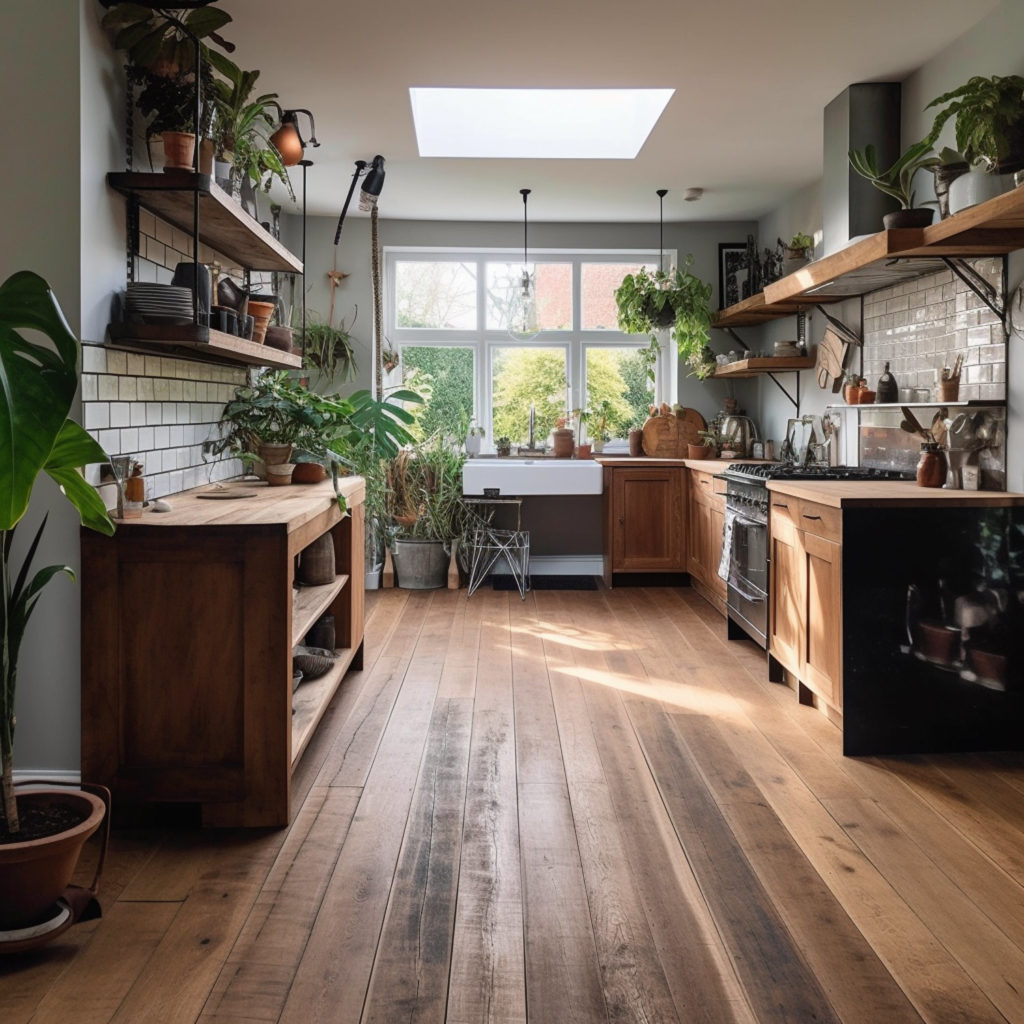The beauty of wood lies in its versatility, and one of the ways to enhance its appearance is by darkening its natural colour. Whether you’re looking to give an old piece of furniture new life or simply wish to alter the tone of your wooden surfaces, there are natural ways to achieve a darker hue. In this article, we will explore various DIY techniques for darkening wood, as well as natural wood finishes like Auro 160, a natural wood stain.
While homemade solutions for darkening wood can be appealing for their affordability and eco-friendliness, it’s important to consider the level of protection they offer compared to commercial natural wood stains such as the one we recommend, Auro 160 Natural Wood Stain. UV protection, water resistance, wear and tear resistance, and a longer-lasting finish are some of the key benefits provided by commercial wood stains that may not be achieved with homemade solutions. When deciding on a natural wood finish, it’s essential to weigh the advantages and disadvantages of each option and choose the one that best meets your needs and priorities.

The Protective Benefits of Commercial Wood Stains vs DIY wood stains
UV Protection
Exposure to ultraviolet (UV) rays from sunlight can cause wood to fade, discolour, and degrade over time. Commercial wood stains often contain UV inhibitors or absorbers, which help to protect the wood from the damaging effects of UV radiation. These additives prevent premature aging and maintain the wood’s colour and integrity for a longer period. Homemade solutions, on the other hand, typically do not offer the same level of UV protection.
Water Resistance
Wood is a hygroscopic material, meaning it can absorb and release moisture from the surrounding environment. This property can cause wood to expand, contract, warp, or rot over time. Commercial wood stains are formulated to provide a water-resistant barrier, preventing moisture from penetrating the wood and minimising damage from water exposure. Homemade solutions may not provide the same level of water resistance, potentially leaving the wood vulnerable to moisture-related issues.
Resistance to Wear and Tear
Commercial wood stains are specifically designed to withstand daily wear and tear, such as scratches, dents, and abrasions. They are formulated with durable resins and binders that help to create a protective film on the wood surface, preserving its appearance and structural integrity. In contrast, homemade solutions may not offer the same degree of resistance to wear and tear, potentially leaving the wood more susceptible to damage.
Longer-lasting Finish
Commercial wood stains are formulated to provide a long-lasting finish that can withstand the elements and resist fading over time. This is particularly important for outdoor applications, such as decks, fences, and exterior furniture, where the wood is exposed to harsh weather conditions. Homemade solutions may not provide the same level of durability, requiring more frequent reapplication and maintenance to maintain the desired appearance and protection.
DIY Methods to Darken Wood Naturally
Tea and Vinegar Solution:
One of the easiest and most affordable methods to darken wood is by using a tea and vinegar solution. Here’s how to do it:
- Brew a strong batch of black tea (use about 5 tea bags per 1 cup of boiling water).
- Let the tea cool down to room temperature.
- In a separate container, mix equal parts of white vinegar and steel wool. Let this mixture sit for at least 24 hours.
- Apply the brewed tea to the wood surface using a brush or a cloth, and let it dry completely.
- Next, apply the vinegar and steel wool solution to the wood, which will react with the tannins in the tea, resulting in a darker colour.
- Allow the wood to dry, and repeat the process if a darker shade is desired.
Coffee Grounds
Used coffee grounds can also be employed to darken wood naturally. Here’s how:
- Collect used coffee grounds and allow them to dry completely.
- Mix the dried coffee grounds with enough water to form a thick paste.
- Apply the coffee paste to the wood surface using a brush or a cloth.
- Allow the coffee mixture to sit on the wood for several hours or overnight to achieve the desired darkness.
- Wipe off the excess coffee mixture and let the wood dry completely.
Baking soda solution
Mix baking soda with water to create a paste and apply it to the wood surface. The alkaline nature of the baking soda reacts with the tannins in the wood, resulting in a darker shade. Allow the paste to dry before wiping off the excess.
Ammonia fuming
This method involves exposing the wood to ammonia fumes in a sealed chamber. Ammonia reacts with the tannins in the wood, darkening it over time. This technique works best with high-tannin woods like oak, and it requires caution due to the hazardous nature of ammonia.
Walnut hulls
Crush the hulls of black walnuts and soak them in water to create a concentrated solution. Apply the solution to the wood surface to achieve a darker colour. This method works particularly well on lighter woods like pine and maple.
Iron acetate
To create an iron acetate solution, mix white vinegar with fine steel wool and let it sit for at least 24 hours. The resulting solution can be applied to the wood surface to achieve a darker colour. The intensity of the colour depends on the concentration of the solution and the tannin content of the wood.
Beet juice
Beet juice can be used to stain wood a darker, reddish tone. Apply the juice directly to the wood surface and allow it to dry. Multiple applications may be necessary to achieve the desired shade.
Pomegranate peel
Boil pomegranate peels in water to create a concentrated solution, then apply it to the wood surface. Pomegranate peel contains natural tannins that can darken the wood.
Sun exposure
Leaving wood exposed to sunlight can cause it to darken over time due to the UV rays. This process, called “photo-darkening,” works well on cherry, mahogany, and walnut, but it can take several months or even years to achieve significant colour changes.
Tannic acid solution
Tannic acid is a natural substance found in various plants and can be purchased in powder form. Mix the tannic acid powder with water and apply it to the wood surface. The solution reacts with the wood fibers, causing them to darken.
Bark extract
Boil tree bark, such as oak or chestnut, in water to create a concentrated solution. Apply the solution to the wood surface to achieve a darker colour. The tannins in the bark will react with the wood, resulting in a darker shade.
Remember that the effectiveness of these methods depends on the type of wood and the presence of tannins in the material. Some methods may produce more subtle effects, while others may result in a more dramatic colour change. Always test the method on a small, inconspicuous area before applying it to the entire surface.
Natural (Commercial) Wood Finishes
When it comes to enhancing the natural colour of wood while also protecting it, natural wood finishes like Auro 160 offer an eco-friendly alternative to synthetic stains and finishes.
Auro 160 Natural Wood Stain
Auro 160 is a water-based, natural wood stain made from renewable raw materials. Free from synthetic additives and solvents, Auro 160 provides a durable finish that emphasises the wood’s natural grain while adding depth and warmth to its colour. The stain is available in a range of shades, allowing you to customise the appearance of your wooden surfaces.
To apply Auro 160:
- Prepare the wood surface by sanding it smooth and removing any dirt, grease, or existing finishes.
- Stir the Auro 160 wood stain thoroughly before use.
- Using a brush or a cloth, apply the stain evenly to the wood, working in the direction of the grain.
- Allow the stain to dry for at least 12 hours. If a more intense colour is desired, apply additional coats, allowing each one to dry before adding the next.
- For added protection, you may wish to apply a natural topcoat, such as Auro 171 Natural Hard Oil, which will seal and protect the stained wood.
Conclusion
Darkening wood naturally is not only a budget-friendly and environmentally conscious choice, but it also adds a unique, personalised touch to your wooden surfaces. By using DIY methods like tea and vinegar or coffee grounds, or opting for a natural wood stain like Auro 160, you can achieve a beautiful, darker hue while preserving the natural characteristics of the wood.

Hi! I’m Chris, the founder of The Organic & Natural Paint Co, and I’m focused on the education and promotion of natural non toxic alternatives to chemical laden everyday products that we just take for granted. We have a choice, and I want to raise awareness of alternative products that don’t actually harm us!
This company is my way of pushing the awareness of better indoor air quality, something that I am personally passionate about due to my own children’s breathing medical conditions. I just couldn’t paint with big brand standard petrochemical paint any longer and wanted another solution.
Read more: About me
Twitter: NaturalPaintCo
Instagram: thenaturalpaintco

















